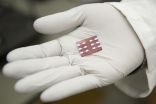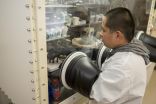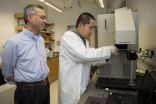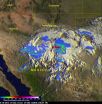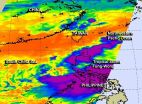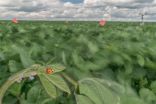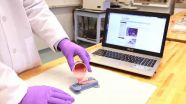(Press-News.org) New light has been shed on solar power generation using devices made with polymers, thanks to a collaboration between scientists in the University of Chicago's chemistry department, the Institute for Molecular Engineering, and Argonne National Laboratory.
Researchers identified a new polymer — a type of large molecule that forms plastics and other familiar materials — which improved the efficiency of solar cells. The group also determined the method by which the polymer improved the cells' efficiency. The polymer allowed electrical charges to move more easily throughout the cell, boosting the production of electricity — a mechanism never before demonstrated in such devices.
"Polymer solar cells have great potential to provide low-cost, lightweight and flexible electronic devices to harvest solar energy," said Luyao Lu, graduate student in chemistry and lead author of a paper describing the result, published online last month in the journal Nature Photonics.
Solar cells made from polymers are a popular topic of research due to their appealing properties. But researchers are still struggling to efficiently generate electrical power with these materials.
"The field is rather immature — it's in the infancy stage," said Luping Yu, professor in chemistry, fellow in the Institute for Molecular Engineering, who led the UChicago group carrying out the research.
The active regions of such solar cells are composed of a mixture of polymers that give and receive electrons to generate electrical current when exposed to light. The new polymer developed by Yu's group, called PID2, improves the efficiency of electrical power generation by 15 percent when added to a standard polymer-fullerene mixture.
"Fullerene, a small carbon molecule, is one of the standard materials used in polymer solar cells," Lu said. "Basically, in polymer solar cells we have a polymer as electron donor and fullerene as electron acceptor to allow charge separation." In their work, the UChicago-Argonne researchers added another polymer into the device, resulting in solar cells with two polymers and one fullerene.
8.2 percent efficiency
The group achieved an efficiency of 8.2 percent when an optimal amount of PID2 was added — the highest ever for solar cells made up of two types of polymers with fullerene— and the result implies that even higher efficiencies could be possible with further work. The group is now working to push efficiencies toward 10 percent, a benchmark necessary for polymer solar cells to be viable for commercial application.
The result was remarkable not only because of the advance in technical capabilities, Yu noted, but also because PID2 enhanced the efficiency via a new method. The standard mechanism for improving efficiency with a third polymer is by increasing the absorption of light in the device. But in addition to that effect, the team found that when PID2 was added, charges were transported more easily between polymers and throughout the cell.
In order for a current to be generated by the solar cell, electrons must be transferred from polymer to fullerene within the device. But the difference between electron energy levels for the standard polymer-fullerene is large enough that electron transfer between them is difficult. PID2 has energy levels in between the other two, and acts as an intermediary in the process.
"It's like a step," Yu said. "When it's too high, it's hard to climb up, but if you put in the middle another step then you can easily walk up."
Thanks to a collaboration with Argonne, Yu and his group were also able to study the changes in structure of the polymer blend when PID2 was added, and show that these changes likewise improved the ability of charges to move throughout the cell, further improving the efficiency. The addition of PID2 caused the polymer blend to form fibers, which improve the mobility of electrons throughout the material. The fibers serve as a pathway to allow electrons to travel to the electrodes on the sides of the solar cell.
"It's like you're generating a street and somebody that's traveling along the street can find a way to go from this end to another," Yu said.
To reveal this structure, Wei Chen of the Materials Science Division at Argonne National Laboratory and the Institute for Molecular Engineering performed X-ray scattering studies using the Advanced Photon Source at Argonne and the Advanced Light Source at Lawrence Berkeley National Laboratory.
"Without that it's hard to get insight about the structure," Yu said, calling the collaboration with Argonne "crucial" to the work. "That benefits us tremendously," he said.
Chen noted that "Working together, these groups represent a confluence of the best materials and the best expertise and tools to study them to achieve progress beyond what could be achieved with independent efforts.
"This knowledge will serve as a foundation from which to develop high-efficiency organic photovoltaic devices to meet the nation's future energy needs," Chen said.
INFORMATION: END
UChicago-Argonne National Lab team improves solar-cell efficiency
2014-09-19
ELSE PRESS RELEASES FROM THIS DATE:
Research predicts possible 6,800 new Ebola cases this month
2014-09-19
Tempe, Ariz. (Sept. 19, 2014) - New research published today in the online journal PLoS Outbreaks predicts new Ebola cases could reach 6,800 in West Africa by the end of the month if new control measures are not enacted.
Arizona State University and Harvard University researchers also discovered through modelling analysis that the rate of rise in cases significantly increased in August in Liberia and Guinea, around the time that a mass quarantine was put in place, indicating that the mass quarantine efforts may have made the outbreak worse than it would have been otherwise. ...
Domestic violence likely more frequent for same-sex couples
2014-09-19
CHICAGO --- Domestic violence occurs at least as frequently, and likely even more so, between same-sex couples compared to opposite-sex couples, according to a review of literature by Northwestern Medicine scientists.
Previous studies, when analyzed together, indicate that domestic violence affects 25 percent to 75 percent of lesbian, gay and bisexual individuals. However, a lack of representative data and underreporting of abuse paints an incomplete picture of the true landscape, suggesting even higher rates. An estimated one in four heterosexual women experience domestic ...
A better way to track emerging cell therapies using MRIs
2014-09-19
Cellular therapeutics – using intact cells to treat and cure disease – is a hugely promising new approach in medicine but it is hindered by the inability of doctors and scientists to effectively track the movements, destination and persistence of these cells in patients without resorting to invasive procedures, like tissue sampling.
In a paper published September 17 in the online journal Magnetic Resonance in Medicine, researchers at the University of California, San Diego School of Medicine, University of Pittsburgh and elsewhere describe the first human tests of using ...
NASA catches a weaker Edouard, headed toward Azores
2014-09-19
NASA's Aqua satellite passed over the Atlantic Ocean and captured a picture of Tropical Storm Edouard as it continues to weaken. The National Hurricane Center expects Edouard to affect the western Azores over the next two days.
NASA's Aqua satellite flew over Tropical Storm Edouard on Sept. 18 at 1:45 p.m. EDT and the Moderate Resolution Imaging Spectroradiometer (MODIS) instrument took a visible picture that showed the eye had disappeared and the bulk of clouds pushed east of center.
At 5 a.m. EDT on Sept. 19, Edouard's maximum sustained winds had decreased to near ...
NASA, NOAA satellites show Odile's remnant romp through southern US
2014-09-19
Former Hurricane Odile may be a bad memory for Baja California, but the remnants have moved over New Mexico and Texas where they are expected to bring rainfall there. NASA's TRMM satellite measured Odile's heavy rainfall rates on Sept. 18, and NOAA's GOES-West satellite saw the clouds associated with the former storm continue to linger over the U.S. Southwest on Sept. 19.
The remnants of Hurricane Odile were dropping heavy rain in the area from southern Arizona to western Texas when NASA-JAXA's Tropical Rainfall Measuring Mission or TRMM satellite flew over on September ...
NASA sees Tropical Storm playing polo with western Mexico
2014-09-19
Tropical Storm Polo is riding along the coast of western Mexico like horses in the game of his namesake. NASA's Aqua satellite saw Polo about 300 miles south-southeast of Baja California on its track north.
NASA's Aqua satellite flew over Polo on Sept. 18 at 4:35 p.m. EDT and the Moderate Resolution Imaging Spectroradiometer captured a visible image of the storm that showed that much of the clouds, thunderstorms and showers were west and south of the center of circulation, and away from the coast. That's an indication that easterly wind shear had increased and were pushing ...
NASA eyes Tropical Storm Fung-Wong move through Northwestern Pacific
2014-09-19
Tropical Storm Fung-Wong continued to affect the Philippines while moving north through the Northwestern Pacific Ocean. NASA's Aqua satellite provided infrared data on the storm's clouds that showed some high, strong thunderstorms with the potential for heavy rainfall over the northern and central regions of the country. The storm is now expected to affect three more countries over the next several days.
The AIRS instrument aboard NASA's Aqua satellite uses infrared light to read cloud top temperatures in tropical cyclones. When Aqua passed over Fung-Wong infrared data ...
Dwindling wind may tip predator-prey balance
2014-09-19
MADISON, Wis. — Bent and tossed by the wind, a field of soybean plants presents a challenge for an Asian lady beetle on the hunt for aphids. But what if the air — and the soybeans — were still?
Rising temperatures and shifting precipitation patterns may get the lion's share of our climate change attention, but predators may want to give some thought to wind, according to a University of Wisconsin Madison zoologist's study, which is among the first to demonstrate the way "global stilling" may alter predator-prey relationships.
"There are all sorts of other things that ...
A two generation lens: Current state policies fail to support families with young children
2014-09-19
September 19, 2014 -- Recent two-generation approaches to reducing poverty that help children and their parents are receiving increasing attention from researchers, advocates, and foundations. By combining education and training for parents to enable them to move to jobs that offer a path out of poverty with high-quality early care and education for children, these programs aim to improve the life opportunities of both. However, according to a new report from the National Center for Children in Poverty (NCCP), State Policies through a Two-Generation Lens, while research ...
Soft robotics 'toolkit' features everything a robot-maker needs
2014-09-19
A new resource unveiled today by researchers from several Harvard University labs in collaboration with Trinity College Dublin provides both experienced and aspiring researchers with the intellectual raw materials needed to design, build, and operate robots made from soft, flexible materials.
With the advent of low-cost 3D printing, laser cutters, and other advances in manufacturing technology, soft robotics is emerging as an increasingly important field. Using principles drawn from conventional rigid robot design, but working with pliable materials, engineers are pioneering ...
